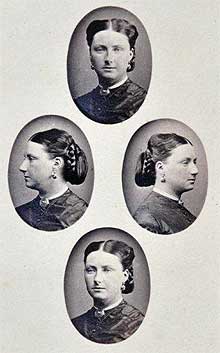
What people are wearing in historical photographs can offer many clues as to the earliest possible date of a portrait, group photograph, or street scene with figures. Dress details may provide additional information, such as the social status of the wearer, their occupation, and sometimes their location or region.
The details need to be compared with fashionable dress of a given date, and then subtle judgments may be made, or additional data supplied through knowledge of the family tree, the photographer's name and address, or the nature of other contributory details such as studio props., or buildings and vehicles included.
Knowledge of the history of photography in terms of various processes and their dates of introduction, styles of image produced such as the carte-de-visite, and the size of images most popular at different times, can also be brought to bear. These combined factors can usually be combined to allow the dress historian to arrive at a close approximate dating for any given photograph featuring people in clothes.
There might be a considerable time lag before London fashions reached the provinces, and older people, while picking up on the contemporary silhouette or material in their dress style, might retain some fashion features and hairstyles from their youth.
 Changes in men's fashions have generally been more subtle, and less sensational than women's, and photographs of even the most well-to-do gentlemen are therefore far more difficult to date accurately by dress alone. In contrast, by the end of the 19th century women's fashions tended to bring in a new detail each season, so the most fashionable ladies' photographs can often be dated to within a year.
Changes in men's fashions have generally been more subtle, and less sensational than women's, and photographs of even the most well-to-do gentlemen are therefore far more difficult to date accurately by dress alone. In contrast, by the end of the 19th century women's fashions tended to bring in a new detail each season, so the most fashionable ladies' photographs can often be dated to within a year.
Some fashion features neatly typify decades, for example men's side partings and women's ringlets in the 1840s, men's centre partings and women's leg-of-mutton sleeves in the 1890s.
Certain features are time limited, such as crinoline frames worn only for eleven years from 1856 to 1867, soft bustles gathered up by internal ribbons in the early 1870s, artificial hairpieces from around 1869 to 1874, fishtail trains on dresses c1876-80, stiff angular bustles over steel frames c1881-6, and the introduction of female fringes and hair frizzing in the 1880s.
Looking at fashion plates and paintings, and original Victorian clothing, as well as observing the dress detail in Victorian novels and diaries, is essential background reference for the dress historian when seeking accurate dating for photographic portraits. Knowledge of tailoring and dressmaking, jewellery styles, trimmings such as furs and feathers, and accessories such as handbags, belts and hats, and of fabrics available and popular at different times, all contribute to making an accurate assessment of date.
It is worth noting that our view of the Victorians' dress sense may have been somewhat distorted by both a tradition for wearing 'Sunday best' in photographs, and the need - in the first fifty years of photography - for photographic studios to issue instructions on what to wear, to achieve the best contrast and detail in black and white. Hence there seem to be few 'white wedding' photographs as white dresses were difficult to capture well, and dark colours and plain designs therefore predominate.
Here follows such an example of a photographer's instructions, presumably based on his bitter experience:

How To Dress When Sitting For A Photographer
Ladies Journal Oct 30 1880
"Very few ladies know how to dress so as to secure the most pleasing photograph. The best materials to wear are such as are not too glossy, and such as will fold or drape nicely, as reps., poplins, satins and silks. A black silk dress looks well on almost everybody, and if not bedecked with ribbons or lace, which will take whiter, will photograph satisfactorily. So garnet, cherry, wine colour, sea or bottle green, light and dark orange, and slate colours are all excellent colours to photograph. But pure white is bad, and lavender, lilac, sky blue, purple and French blue take very light, and dresses having bold patterns upon them, should never be worn for a picture. Avoid anything that will look streaky or spotty".

Lady with parrots c1878
What is extraordinary, in a way, is that there are cartes-de-visite photographs of Victorians from Britain and their aspiring contemporaries overseas, taken at photographic studios abroad in Europe and indeed all over the world, from Montreal to Calcutta, and they are testimony to the strength of the British Empire, and the Courts of Europe, in influencing fashions down to the last detail, and for being surprisingly up-to-date, especially in the period 1870-1910. In many ways the dress looks more English than the English, and with few concessions made to warmer climates!
Select Bibliography
- Gernsheim, Alison Fashion & Reality, Dover 1963 Reprinted as Victorian and Edwardian Fashion: a Photographic Survey, Dover, 1981
Ginsburg, Madeleine Victorian Dress in Photographs, Batsford, 1982 - Lansdell, Avril History in Camera, Shire Albums
- Wedding Fashions 1860-1980, 1983
- Fashion a la Carte 1860-1900, 1985
Seaside Fashions 1860-1939, 1990 - Everyday Fashions of the 20th century, 1999
- Walkley, Christina Dressed to Impress Batsford, 1989
Fashion in photographs
- National Portrait Gallery series, Batsford
- Lambert Miles Fashion in Photographs 1860-80 pub. 1991
- Levitt, Sarah Fashion in Photographs 1990-1900 pub. 1991
- Rolley, Katrina Fashion in Photographs 1900-1920 pub. 1992
- Owen, Elizabeth Fashion in Photographs 1920-40 pub.1993


